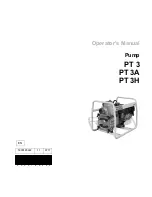
3-1-618 Page 7
High pressure fluid from hand held or hand
directed pressure and flow directing devices
may overpower an operator’s ability to
control or direct the device, which could
lead to personal injury, death and/or
equipment damage. The operator must
brace against the backward thrust of a hand
held device. In addition, a safety harness or
safety net must be used when working in an
area where the operator could be injured in
a fall. Stand to the side of any tubing or
container being sprayed to avoid back spray
and never operate a hand held device
above shoulder level.
Never direct the pressurized fluid stream at
yourself or any other person, control valves,
the pump, pump drive, suction or discharge
systems. The pressurized stream can
cause serious personal injury or death and
can also change valve or control settings
which could dangerously increase the
delivery pressure to the pressure and flow
directing device.
When operating a pressure and flow
directing device, use only equipment which
automatically shuts off flow when an
operator releases hand or foot pressure on
the pressurized flow trigger control to
prevent injury if the operator is overpowered
or becomes disabled.
Check to insure this automatic shut-off
equipment is operating properly before
every use and never circumvent the
automatic shut-off for any reason or by any
means when operating the equipment.
When operating any type of high pressure
liquid jetting, blasting or cleaning devices,
the operators must always wear protective
clothing including, but not limited to, a hard
hat with full face visor, heavy duty rain coat
and pants, boots with nonskid sole and
safety toe, rubber gloves with rough grip
surface and ear noise protection.
Full operator attention and alertness are
required when operating this equipment to
avoid
personal
injury,
death
and/or
equipment damage. The operators should
take frequent rest breaks and cease
operations when they become tired or
distracted.
Before the equipment is started, the work
area must be inspected and properly
prepared to avoid personal injury, death,
and/or damage to equipment. Make sure
the work area is checked for hazardous
fumes, has adequate ventilation for engine
exhaust and sufficient drainage for released
fluid. Check the work area for electrical
equipment, connections, outlets, fixtures, or
lines. If any are present they must be made
water tight and the electrical power to these
devices must be shut off to avoid electrical
shocks from fluid contact. The work area
should be clearly marked and roped off to
keep unauthorized people and vehicles from
entering. Remove all loose parts, tools and
equipment from the work area before
beginning operation.
All pressure containing devices including
wands, nozzles, guns, hoses, connections,
etc., should be regularly checked for
condition. These components should all be
tagged with their tested pressure capabilities
together
with
the
date
testing
was
performed. Always be aware of the
pressure level in the system and never
connect any equipment to the system
which has a rated or tested pressure
capability below the system operating
pressure. The equipment must be shut
down and the system pressure released
before changing or disconnecting wands,
nozzles, guns, hoses, connections or any
other pressurized system components.
All pressure containing devices including
wands, nozzles, guns, connections, etc.,
plus all automatic shut-off, pressure and
control equipment should be treated with
care. Protect them from damage by people,
objects and vehicles. Never lay them in
dirt, mud, ice or other loose material which
could plug the fluid opening or interfere with
their operation. Never use the wand,
nozzle, gun, etc. to pry loose material off
items being cleaned.
Before
starting
operation
in
a
cold
environment, check to make sure there is
no ice in the fluid system and repeat this
inspection each time before operation is
restarted.














































